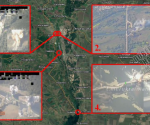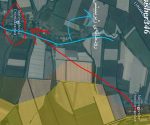Under pretence of dealing with Iran, Israel goes after air defences; Russia should rethink the S-300 to Syria
The Israel-versus-Iran psyop, generated by aggression in Syria by the former, supposedly in response to the presence of the latter, and promulgated by corporate and alternative media alike, continues apace. On May 9th/10th, contrary to what everyone is supposed to believe, it was the Syrians, not the Iranians, who fired artillery shells, and perhaps even ballistic missiles, onto Israeli military positions in the Golan Heights. In the quarters of the internet where this is understood, there is also an idea that Syria’s action was somehow a venting of frustration; payback, at last, for the years of abuse consisting of countless occasions in which Israel has dropped a bomb somewhere in Syria in support of the mercenary jihadist proxy forces fighting there on behalf of the US and the UK, to name the main perpetrators (Zionism is a function of British Israelism, hereabouts better understood as a faction of Masonic Globalism). In fact, it appears as if Syria’s response was for good tactical reasons, and if Russia, as some commentators say, doesn’t want to supply S-300 to the Syrians in order to prevent a conflict escalation, it had perhaps better think again.
According to the Israelis, attacks on “nearly all the Iranian infrastructure in Syria” were launched in retaliation for an unprovoked assault by the Iranians – the Revolutionary Guards’ Al-Quds Force to be precise. The incident has been called the “most extensive Israeli attack in Syria since 1974”, and the alleged provocation by the Iranians, the first incident in which they had fired directly upon Israel.
Obviously, such impudence demanded a big Israeli stick. The following was from Israeli Defense Minister Avigdor Liberman:
The Iranians attempted to attack Israeli territory, but not a single missile hit Israel. Some fell in Syria, and some were shot down by the Iron Dome. We have hit almost all the Iranian infrastructure in Syria.
RT also captured some of the Israeli bragging for Western consumption:
“Iran will need a lot of time and resources to rehabilitate its operational, military and intelligence infrastructures we hit tonight,” an IDF spokesman said, according to Ynet, warning that “any other attempt” to hurt Israel will “pay even more.”
This propaganda was parroted extensively by the corporate-media; and even the likes of Southfront, which presumably does it to try to appear unbiased, is prone to uncritically repeating tall stories to turn them into substantiated fact. However, none of it is believable – and, given the Israeli track record, we can make this judgement even before we consider the rest of the evidence. And when one does look at all the information, what actually becomes clear is that the reason why the Israeli attack was so extensive was because it comprised of combined elements that were trying to knock out Syrian air defences.
But let’s unpick the Israeli fantasy apart piece by piece. Firstly, the Israelis, either directly from Government spokesmen, or indirectly through Israeli corporate-media, have what, in judicial circles, is called “previous”, even within very recent memory. There should be no excuse for not knowing of it: Israel lies about its military failures. That F-16 that Syria shot down over Lebanon in fact had developed an “operational failure” which led to a crash. Syria’s air defences had been comprehensively destroyed in that unsuccessful Israeli onslaught that took place just before all those French, US and UK missiles were shot down (as discussed in a previous FBEL piece). Indeed, at least one Iranian MP called out the new Israeli claim of Iranian aggression as a lie, pointing out that “Israel’s history of carrying out unprovoked attacks in Syria has been well-documented.” There can’t be any arguing on this point with Mohammad Javad Jamali Nobandegani, a member of the Iranian Parliament’s national security and foreign policy committee, who also thinks that Israel “wants to create Iranophobia in the countries of the Persian Gulf and among American allies”.
Nobandegani went on to state that Iran just doesn’t have the infrastructure in Syria that the Israelis have been boasting of destroying – and if there is any untruth about this precise point of fact on the Iranian’s part, it is surely because his country clearly won’t participate in Israel’s game. It’s a game which would be sure to end in giving the USA a pretext to do something to spoil Iran’s current progress to being a stable regional power, and thereafter a developed nation. It boils down to this: the Iranians don’t feel sufficiently threatened by Israel to provide that pretext, and so Israel is trying to create a theatre for world perception in which they are, and they do.
The truth, as it appears to us according to all the data, was that there was no unprovoked attack either by the Syrians or the Iranians – there was just an Israeli assault, which had a focus that wasn’t aimed at the Iranians. Consider this information from SANA:
The Syrian Arab Army’s air defenses repelled an Israeli missile aggression on Syrian territories, shooting down scores of missiles.
A military source said the army’s air defenses shot down tens of Israeli missiles, preventing most of them from reaching their targets, while some managed to hit a number of air defense battalions, radars, and an ammo depot.
SANA’s correspondent said that information indicates that the Israeli aggressions targeted air defense battalions and radars in Syria with missiles fired by enemy warplanes from within the occupied territories.
(Source).
And this:
The General Command of the Army and Armed Forces said that Air Defense of the Syrian Arab Army managed with high efficiency to intercept and destroy a large part of the Israeli missiles launched consecutively on Thursday at dawn at a number of military posts in several directions.
In a statement, the Army General Command said that… the remaining part of the missiles resulted in the martyring of three people and the injuring of two, in addition to destroying a radar station and an ammunition depot.
(Source).
As an aside, notice that once again, the Syrians thought that they did rather well. Indeed, we are invited to believe by the admission of the casualties, which is something that the Syrians always tend to do (and, according to all accounts, would be unheard of in an Israeli Defence Force’s briefing); it always gives the impression of a sigh of relief that, by their own devices, the Syrians prevented things from being much worse than they could have been. So, as for actual numbers: various reports speak of a 70% success rate – which is a number that the Russians appear to have come close to confirming according to reports of their assessment of “more than 50%” of 60-plus Israeli missiles downed. This is a similar result to the fiasco by the “major powers”, which was universally deemed a giant failure, except in the pages of Anglo-globalist corporate-media.
The main detail to notice, however, is that the Israelis were evidently attacking portions of the Syrian air defence system. This is completely consistent with the analysis conducted here at FBEL which has concluded that Syria has made its skies nigh-on impregnable for the Israelis. So, when hitting the primary objective becomes impossible, then the new first target must, by necessity, become that which is proving to be the obstacle to the main mission. In short, the Israelis have discovered that they can no longer, with impunity, give air support to the US/UK proxies in Syria, which is the primary objective (which has usually been executed under the pretext of denying weapons to Hezbollah). Therefore, they have had to deal with the obstacle: the Syrian air defences. The Syrians clearly appreciate this themselves, as evidenced in another SANA report:
Foreign and Expatriates Ministry affirmed that the Israeli aggression on Syrian territories came within the framework of the aggressive approach of the Zionist entity and in response to the defeat of its tools of the terrorist groups.
In the framework of the aggressive approach of the Zionist entity and in respose to the defeat of its tools of terrorist groups , it targeted with a number of missiles some military sites where most of the missiles were repelled efficiently by the air defense of the Syrian Arab Army, an official source at the Ministry told SANA.
The source said that “the direct aggression of the Zionist entity and its supporters indicates that a new phase of the aggression against Syria has begun with the original enemies after the defeat of the agents,” adding that the Syrian Arab Army will confront them.
And there’s more to this than meets the eye. Consider this, also:
Meanwhile, SANA’s correspondent in Quneitra said the Syrian air defenses shot down Israeli missiles over al-Baath city, adding that prior to that the Israeli enemy fired shells at the city but they didn’t cause any injuries.
The reader will realise that al-Baath must be close enough to Israeli military positions for it to targeted with land-based weapons ranged from the other side of the current boundary between the two countries. Here’s another account of great interest, this time by the Twitter user @WaelAlRussi – a source on the ground that FBEL has cited before. It tells of the sequence of events on the night of the incident:
1 #Israel Targeted SAA in south #Syria
2 #SAA responded by targeting the Israeli army positions in Jolan Heights
3 Israel tried to target Syrian positions with Stand-off missiles
4 SAA intercepted 70% of the missiles and re-targeted Israel
What these reports suggest is that there was a combined Israeli attack, with the land element coming in advance of the air, with an objective to destroy Syrian air defence sites and placements. And there’s more. One particular Pantsir-S1 battery was destroyed, not by a stand-off cruise missile, but by a drone (an IAI Harop). Moreover, the Pantsir unit was hit after it had deployed its munitions, and presumably therefore had revealed its position to Israeli operators looking for one that was exposed.
It appears as if the Syrians were quick to realise what was going on – and that’s why they responded with their own barrage into Israel. It wasn’t some kind of act of emotional purgation. Because Israel was attempting to punch through Syria’s air defences from the ground, it became imperative for the Syrians to do something to counter the stroke in order to maintain the integrity of their air defences.
That the Syrians provided the required deterrent by firing shells and missiles on Israeli military targets is suggested by the resultant relative Israeli failure; i.e. a ground-based element of the Israeli operation may well have been restricted so that the Israelis were left to rely on their stand-off missiles. It’s a good bet that the Israeli’s did not expect the Syrians to respond in the way that they did – so there must have been shock in the same way suffered by an aversion therapy patient – and if one examines what the Syrians targeted, the question one needs to ask is how much does it appear as if they were looking to reduce the Israeli capability to maintain an attack.
Apparently, the Syrians lobbed off more than 50 bombs themselves (some sources say the number was near 70). They were aimed at the following:
A HQ of the border brigade 9900
A HQ of the border brigade 810
A technical and electronic survey facility
A HQ of the EW jamming facility
A communication and transmission facility
A helicopters airfield
An outpost at Hermon Mount
Alpinist unit HQ
(Source).
@WaelAlRussi reports that the following were actually hit:
Iron dome radar in Safad
3 Israeli forward position
Helicopter pad near Um Fahem
Position near Jerusalem
A layman certainly cannot hope to translate it into “national military strategy for beginners”, but this list of targets certainly does not smack of being random, and suggests a method that will likely have deep meaning to the Israelis, and inform them that the Syrians know where to effectively place a missile. We shouldn’t expect the Israelis to admit to any damage, and of course, Avigdor Liberman has been quoted above as saying that noting landed in Israel, but there are reports that the so-called Iron Dome was not as certain as the SyADF. One sign of the effectiveness of the Syrian response may well be that we don’t see further Israeli aggression, because the Israelis now know what to expect if they try to undermine Syrian air defences. Of course, there is a risk that Israel will proceed regardless of any price it has to pay, and use Syria’s necessary retaliation to goad the Americans into an escalated form of conflict with Damascus, which won’t necessarily be successful, but by its weight will undo all the progress that the Syrians have made, and bring Russia closer to having to punch the Americans on the nose. Again, these prospects are something that are very apparent to the Syrians:
The [Foreign and Expatriates Ministry] source concluded by saying that the aggressive behavior of the Zionist entity will not succeed in reviving the defeated conspiratorial project in Syria rather it will only increase tension in the region, which poses a serious threat to international peace and security
There is an argument associated with the Russian decision not to supply Syria with the S-300 air defence system, and it relies on the idea that such a deployment will provoke retaliation from Israel. The answer to this argument is, so what? The Israelis have demonstrated that they want to take out Syrian air defences whatever their model or their level of sophistication. What needs to be done is a reinforcement of Syria’s ability to deny its airspace to the aggressive Israeli – which ultimately means shooting down planes. If the Russians made their more modern equipment available to the Syrians, it wouldn’t be that Israel’s historical air superiority would be denied, it’s a question of to what extent it would be, and surely, it is in the best interests of the region to have Israeli planes grounded for the very real fear of a 100% chance of being shot out of the sky. The alternative appears to be a path to escalation – because while the Israelis think they can do as they please, as they demonstrated once again with a brand new wave of murdered Palestinian protesters, then they most certainly will.
Then again, the Syrians do shoot back.


















